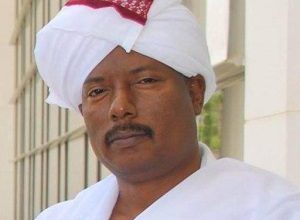From Where has he come, this Hemedti? (2-2)

Abdallah Ali Ibrahim
Sudanese novelist, Tayeb Salih, was once quoted as saying “from where have these people come?” when he was struck by the series of human rights violation committed by the salvation regime during its rule of Sudan, 1989. The phrase then stuck with the regime like a curse, hasn’t it came from one of the custodian of the Sudanese spirituality.
And many people are chocked today in face of the war led by the Rapid Support Force (RSF) and its cruelty, to the extent that they asked the same question “from where have these people come?”.
The RSF, according to Julie Flint’s book on the Janjaweed, is a legitimate product of the drought and desertification that struck North Darfur as part of the African coast during the 1970s and 1980s. It was accompanied by two demographic shocks. These successive drought waves first shook the Arab Abbala (camel herders) in North Darfur, tribes related to the Rizeigat people, many of whom, however, were cow herders (Baqara) in South Darfur. The northern desert in Darfur was devastated, and their stronghold was no longer fit to live in, and the Camel herders had to move out to seek sustenance elsewhere but in so doing they transgressed.
On the other hand, groups of Chadian Arabs who were struck by drought, same desert creep, and the scourges of civil war migrated to Sudan. The peak of this migration was in the mid-eighties, when Colonel Muammar Gaddafi adopted the Arab Islamic Belt project into Africa in various forms. Some of these Arabs came at the invitation of their families in Sudan to strengthen their ranks for one purpose or another. Despite the availability of water and pasture for them, they felt sad in their souls that they are without a “home area – Hakoura” in their diaspora, and this is a great shortcoming that makes a person feels like a second-class citizen among those who hosted him in their home, and it became, in Flint’s words, “the priority of those Arabs to possess the Hakoura for their tribe, given their alienation in Darfur is derived from the Native Administrative and political power that come with owning such Hakoura.” For this purpose, they set their sights on the inhabitants of the fertile valleys of the Fur people in the west and south of Jebel Mara. So they began an alliance with Arabs from Sudan to expel the Fur from their homes by burning their homes. The Misseriya of Chad burned 10 villages west of the town of Kass in one night during October 1987, and the new inhabitants established one new village in the name of N’Djamena, the capital of Chad.
The time came for the government to invest in the existential plight of the Arab shepherds for their project of empowering themselves. This was accompanied by developments in South Sudan in 1991. The “Ingaz” needed men to recruit them into what it called the “Peace Brigade” in exchange for a license to occupy Dar Fur, west of Jebel Mara. The camel raisers, Mahameed of Abala, occupied North Darfur, west of the mountain, while Beni Hussein occupied its south and west. The share of Salamat and Mahadi among the Arabs of Chad was the valley of Azum, descending from the mountain. Then the government seized the mountain for itself by using it to fight the Darfur armed movements that rose to the opposition in 2003. The government adopted the practice of burning villages to expel their inhabitants to IDP camps on the outskirts of the cities.
Here comes the point that Flint wanted to raise, which is that the Arab-Zurga war coincided with a war of Arabs against each other as well. This land expropriated from Fur was a cause of discord among those Bedouins themselves. The Houtiyya, who are Arabs from Chad, disputed with the Nawaiba from Camel Raisers, North Darfur, over such land in the town of Zalingei in 2007, and 250 of them were killed. The Tarjum also fought against the Maher Rizeigat, resulting in 500 deaths. The two defeated, Al-Tarjum and Al-Houtiya, concluded an alliance to which they included Al-Barqo (from Zurqa) and Al-Thaalabah from Kordufan State. They also included the Misseriya from Kordufan State, with old connections to the government, which had well prepared them for the SPLM war in South Sudan, but they were no longer needed after the conclusion of the Comprehensive Peace Agreement in 2005.
In February 2007, the camel raisers of North Darfur and the Tarjum fought over Wadi Bulbul, which originally belonged to the Fur. It was occupied by the Tarjum, the people who did not have home in the 1990s. They were the first to volunteer for conscription with the government, so that the government would give them a home without which they were born. Competing with them for the valley came the sons of Mansour from the Mahariya, the family of Mohammed Hamdan Dagalo, who migrated from North Darfur in the late 1980s to South Darfur. The disputing parties mobilized their supporters from Chad. The Camel Raisers defeated the Tarjum severely and plundered thousands of their cattle, leaving 70 dead and 50,000 displaced from 52 villages, four of which the camel raisers burned. The Camel raisers returned to the Tarjum in July 2007, killed 172 of them, buried them in one grave, and took away their crops and cattle.
In another battle, border guards killed 30 Tarjum. The threat of Camel Raisers towards the Tarjum disappeared when Hemedti himself rebelled against the government and threatened to occupy the city of Nyala due to the government’s delay in paying the salaries of his soldiers.
The war revealed the extent of the devastation that occurred as a result of the availability of government weapons in the hands of the tribes, such as Katyushas, rocket-propelled grenades, and 10 rifles, let alone the 4X4 troop carriers, which were provided to them by the Border Guards Intelligence Battalion. The Camel raisers of North Darfur were recruited by those whose profession had become fighting when the doors to other livelihoods were blocked in their faces.
The inter-Arab war did not stop. In February 2010, the Misseriya and Rizeigat war took place. The northern Rizeigat Camel Raisers entered it with border guard’s weapons and the types of equipment mentioned above. For their part, the Misseriya summoned their relatives from Chad and Baggara Jebel Mara to attack the neighborhoods of the Camel Raiser, Al-Nawaiba, who in turn summoned the Arabs of Beni Hussein, Al-Mahdi, Awlad Rashid, Al-Areqat, Al-Mahariya, and Umm Jalloul, led by officers from the border guards.
This war revolved around who among the Arabs shall have ownership of the stolen Fur land? Witnesses reported that heavy weapons were transferred to Hemedti from the border guards. Confirmed reports stated that the Misseriya sought help from a group of their people who defected from the Chadian Forces for Change and Democracy.
You will not be far from core if your answer is limited to the question: From where have these Arabs, the Janjaweed, come? According to your statement: they have come from the womb of the government center. But it is an answer in the case of the search of someone he had lost under well-lit place while he had lost it in a different dark place. If we content ourselves with accusing the government of creating the “Janjaweed” industry, we may be doing a good job of opposition, while falling short of penetrating the destabilizing conditions in the countryside. In it, the customs of land ownership combined with the natural occurrences and the erosion of ways of life such as pastoralism, along with the illusion of the borders of the nation-state, with the violation of the commodity economy into rural production, to emerge from it like North Darfur Camel Raisers who had to reproduce themselves out of their extreme isolation and poverty. The rebellious state came to them not to remove the rust from their lives, but to hire them to kill its opponents without any known reason, under duress, not as heroes. The latter narrative prevailed over the former. It is a predominance that deprives us of understanding the “RSF” war, the second stage of “Janjawidism”, so we only see it emerging from the womb of the center of the “Ingaz” state, not the combination of policies in the countryside and the region that prepared its exit from that womb. It was said that those who were ignorant of their history, will repeat it, in most cases, at a high cost for that matter.



